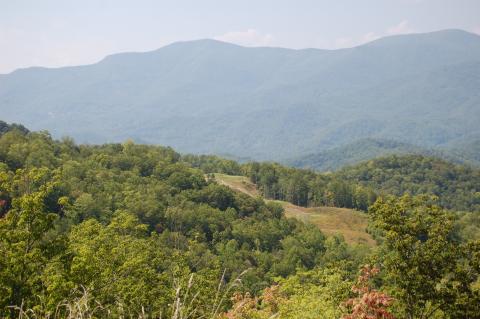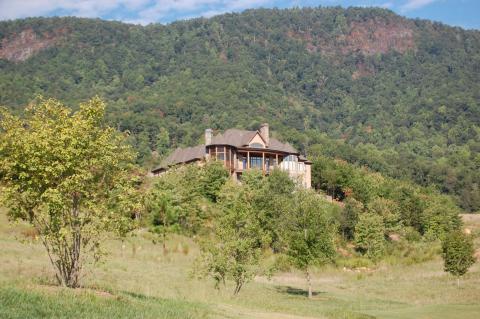

The tee shot on the 8th hole at Balsam Mountain Preserve is a blind one (top photo) to a downhill fairway with a creek at its end, just in front of the green. The approach shot, above, is all hit or miss badly. All photos by L. Gavrich (Note: Click on small photos below for larger versions and captions)
Palmer, Fazio mountain golf courses rate the same but play different
From the tips, the courses at Balsam Mountain Preserve and Bright's Creek are remarkably similar in length and degree of difficulty. Both play to about 6,900 yards and sport identical course ratings of 72.9. From the more moderate members tees of around 6,400 yards, the ratings are almost identical as well, 70.1 for Balsam Mountain and 70.5 for Bright's Creek. The slope ratings from the members' tees almost match up too, 136 and 134 respectively. The settings, routings and player experiences on the courses, though, are considerably different.
Tom Fazio might have wound up designing both courses if he had liked the top of the mountain location at Balsam, but sources told me he thought the site would force compromises in the routing. He suggested an alternative site a few miles away and a couple thousand feet down the mountain, an idea rejected by Balsam's developers, Chaffin & Light. Palmer Design literally rose to the occasion to carve 18 holes from the mountain. At Bright's Creek, there was never a doubt it would be Fazio, who had designed the course at developer Barton Tuck's other community, the ultra-private and well-reviewed Forest Creek Club in Pinehurst, NC.
location at Balsam, but sources told me he thought the site would force compromises in the routing. He suggested an alternative site a few miles away and a couple thousand feet down the mountain, an idea rejected by Balsam's developers, Chaffin & Light. Palmer Design literally rose to the occasion to carve 18 holes from the mountain. At Bright's Creek, there was never a doubt it would be Fazio, who had designed the course at developer Barton Tuck's other community, the ultra-private and well-reviewed Forest Creek Club in Pinehurst, NC.
After playing the Balsam Mountain course, I think I understand something of what Fazio saw in the site. Although some of the holes on Arnie's routing are as interesting as they are beautiful, overall I found the layout a little too brawny, especially on a day when I was not hitting the ball straight. There were just too many opportunities for a slightly errant shot to ruin your day. The course is challenging to be sure, but exhausting as well.
Things got off on a bad footing for me on the first hole, which required a play down the middle to the left side of the fairway, away from a cliff that ran along the entire right side. I pushed my tee shot and approach shot and lost a couple of balls, my fault, not Arnie's. But on the rest of the course, it seemed the King was forced to squeeze a hole in here and there, nowhere more so than the eye-popping 8th, a short par 4. The tee shot there is entirely blind, up and over a steep hill whose other side is also steeply sloped down toward the creek in front of the green. A choice of driver for all but the longest hitters is fine off the tee, but when you get to the top of the hill, look back up at the tee, and then straight down to the green, you can't imagine how a good drive could stop short of the creek. A waste area beyond the green gobbles up overly aggressive approaches, as it did mine. It is a memorable hole, if not a classic one.
to the left side of the fairway, away from a cliff that ran along the entire right side. I pushed my tee shot and approach shot and lost a couple of balls, my fault, not Arnie's. But on the rest of the course, it seemed the King was forced to squeeze a hole in here and there, nowhere more so than the eye-popping 8th, a short par 4. The tee shot there is entirely blind, up and over a steep hill whose other side is also steeply sloped down toward the creek in front of the green. A choice of driver for all but the longest hitters is fine off the tee, but when you get to the top of the hill, look back up at the tee, and then straight down to the green, you can't imagine how a good drive could stop short of the creek. A waste area beyond the green gobbles up overly aggressive approaches, as it did mine. It is a memorable hole, if not a classic one.
Balsam Mountain is not a course for any but the straightest hitters. I carried shots over the middle of hills and failed to find my ball on the other side. (I lost a dozen balls at Balsam Mountain, my own fault for playing a mountain course without a member.) Local knowledge is just about everything at Balsam Mountain, in addition to hitting the ball straight, and the hints Balsam's friendly pro shop staff offered me before the round were helpful but not enough to staunch the flow of my Bridgestone 330s into the local forests.
I found the hardest-hole designations on the scorecard a little odd. The short par 5 4th hole was one of the easiest I played all day, albeit beautiful, but it is down as the #1 handicap hole. My notes on the long (447 yard) par 4 16th hole indicate that it "plays tougher than a #10 handicap"; I wrote a side note that the shorter par 4 15th hole "played easier than its #4 handicap." Although a 450-yard par 4 is longer than my game can accommodate these days, distances at the 3,500 feet high course didn't seem to matter nearly as much as hitting the ball straight. The longer holes feature elevated tees and downhill plays that soften the lengths you go to reach the greens in regulation.
was one of the easiest I played all day, albeit beautiful, but it is down as the #1 handicap hole. My notes on the long (447 yard) par 4 16th hole indicate that it "plays tougher than a #10 handicap"; I wrote a side note that the shorter par 4 15th hole "played easier than its #4 handicap." Although a 450-yard par 4 is longer than my game can accommodate these days, distances at the 3,500 feet high course didn't seem to matter nearly as much as hitting the ball straight. The longer holes feature elevated tees and downhill plays that soften the lengths you go to reach the greens in regulation.
Conditions at Balsam Mountain are remarkably good given that the full 18 holes have been opened barely a year. I didn't have a bad lie all day -- that is, when my tee shots found the short grass -- and greens were smooth and medium fast. Arnie's layout is also long on postcard-beautiful mountain vistas. On a clear day, you can see a few dozen miles in all directions, a pleasant and welcome distraction if your game, like mine, goes in one of those directions...namely south. Tom Maybank, the sales associate at Balsam who kindly showed me around the community, indicated that developers Chaffin & Light do not consider Balsam Mountain strictly a golf community. Do not take that to mean the course is window-dressing, although any of us would be happy to have some of those views to dress up our windows. The course is tough and not for the casual golfer. The better player who sees intimidating carries over ravines and blind shots over hill and dale as one way golf was meant to be played should like it a lot. I liked the course, but my best shots were through the camera lens.
The Bright's Creek golf course takes a lower road, literally, by playing in what looks like a valley but is actually more than 1,000 feet in elevation. The course, which traverses land that was formerly home to a cattle ranch, is unmistakably Fazio, with all the customary touches and holes that flow one after the other as if the designer had an unlimited amount of land at his disposal. For the eye, the recognizable large Fazio bunkers are there, nestled into the banks on the sides of the fairways and greens and framed by the surrounding mountains that rise 3,000 feet above the course. The banking around the fairways -- Fazio's signature funneling -- rescue some wayward tee shots from finding trouble outside the boundaries of the fairway, but the fairway bunkers will gobble up slightly stray drives. Depending on what end of the bunker you find, you face either a tempting play to the green or a disappointing wedge back out to the fairway because of the bunker's lip in front of you. Fazio's bunkers at Bright's Creek are not there for visual appeal along, that is for sure.
but is actually more than 1,000 feet in elevation. The course, which traverses land that was formerly home to a cattle ranch, is unmistakably Fazio, with all the customary touches and holes that flow one after the other as if the designer had an unlimited amount of land at his disposal. For the eye, the recognizable large Fazio bunkers are there, nestled into the banks on the sides of the fairways and greens and framed by the surrounding mountains that rise 3,000 feet above the course. The banking around the fairways -- Fazio's signature funneling -- rescue some wayward tee shots from finding trouble outside the boundaries of the fairway, but the fairway bunkers will gobble up slightly stray drives. Depending on what end of the bunker you find, you face either a tempting play to the green or a disappointing wedge back out to the fairway because of the bunker's lip in front of you. Fazio's bunkers at Bright's Creek are not there for visual appeal along, that is for sure.
At Bright's Creek, Fazio does not seem his usual manic self about "burying" cart paths, although the paths do not come near the field of play to help or hurt a wayward shot. The course is in supreme condition, the turf maybe just a little immature given its four-year vintage but good enough for pro-tournament conditions. The greens had been aerated the day before we played, and they still putted fairly true and were remarkably speedy. Preliminary rounds of the Nationwide Tour BMW pro-am are played at Bright's Creek before moving on for the finals at The Thornblade Club, in Greer, SC, less than an hour away. (I have played the terrific Thornblade, a 20-year old Fazio classic in a neighborhood where pro golfer Jay Haas lives.) Bright's Creek plays to a robust 7,435 yards for the pros, but the length for them -- and for us mere mortals -- is really in the par 3s, which mostly play beyond 200 yards from the back tees.
Eventually, according to sales associate Michael Waldrop, who played the course with me, Bright's Creek will feature three golf courses, including one to be sited on an adjacent mountain. That is a lot of golf holes for just 1,200 homes when the community is fully built, but developer Barton Tuck has experienced great success at his Forest Creek community in Pinehurst, where 36 holes get plenty of play and positive notoriety. Success breeds confidence.
That is a lot of golf holes for just 1,200 homes when the community is fully built, but developer Barton Tuck has experienced great success at his Forest Creek community in Pinehurst, where 36 holes get plenty of play and positive notoriety. Success breeds confidence.
In these tumultuous times, the reputation, experience and financial health of a community's developer is more important than ever. Balsam Mountain Preserve is being developed by Chaffin & Light, a 30-year old organization responsible for the successful Chechessee Creek Club in Okatie, SC, whose well-respected golf course was designed by Bill Coore and Ben Crenshaw. Chaffin & Light has also developed two communities in Colorado and cut their teeth at Sea Pines Plantation on Hilton Head Island in the late 1970s. Bright's Creek is the brainchild of Barton Tuck who has just the Forest Creek community on his resume. But Forest Creek and its Fazio courses are a model for high-status private club communities.
The developers of both these top-drawer communities appear to meet all the standards for high-end properties, and they offer golf memberships half the price of their highest-end competitor in the area, The Cliffs Communities (currently $150,000 but for access to eight courses). The track records of Chaffin & Light and Barton Tuck are solid, and their latest two communities should enhance their reputations, as long as the net wealth of those in their target markets does not erode any more. Neither community provides any clear signage near their entrances, and finding Balsam Mountain and Bright's Creek can be a little challenging. But for those who can afford it, getting there could very well be worth the effort.
Balsam Mountain Preserve, 81 Preserve Road, Sylva, NC. Tel: 866.452.3456. Web: BalsamMountain.com
Bright's Creek, 2222 Palmer Road, Mill Spring, NC. Tel: 866.302.7335. Web: BrightsCreek.com
If you are interested in visiting these communities or in more information, contact me and I will be happy to put you in touch with someone who can help you. Also, if you would like me to email you a copy of the scorecards from either course, just send me a note using the "Contact Us" button at the top of the page.

The approach to #12 at Bright's Creek, a par 4, is vintage Fazio, with bunkers that can give you a lot of lip.

























